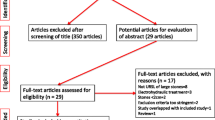Abstract
Percutaneous nephrolithotomy (PNL) is the primary treatment option for renal stones > 20 mm in diameter. Mini-PNL gained popularity with its minimally invasive nature. The aim of this study was to compare the efficiency of ballistic and laser lithotripsy with the combined use of both techniques. Data of 312 patients underwent mini-PNL for renal stones with Hounsfield Unit > 1000 was investigated retrospectively. We identified 104 patients underwent combined ballistic and laser lithotripsy. Propensity score technique was used to create the laser and ballistic lithotripsy groups. Groups were matched on stone size, stone density, and Guy’s stone score. Primary end point of the study was to compare the stone free rate (SFR), complication rates, and duration of surgery. Mean age of the population was 49.4 ± 6.1, stone size was 24.6 ± 6.3 mm, and stone density was 1215 ± 89 HU. The groups were similar for age, stone size, stone density, and Guy’s stone score. The SFR and the complication rates of the 3 groups were similar (p = 0.67). The duration of the surgery was shorter in the combined group (46.1 ± 6.3 min) compared to the laser lithotripsy (54.5 ± 6.6 min) and ballistic lithotripsy (57.2 ± 6.9 min) groups. Both laser and ballistic lithotripsy are effective methods for stone fragmentation during mini-PNL. Combined use of both methods has the potential to improve the fragmentation rates and diminish the operative times in case of high density stones.
Similar content being viewed by others
References
Assimos D, Krambeck A, Miller NL, Monga M, Murad MH, Nelson CP, Pace KT, Pais VM Jr, Pearle MS, Preminger GM, Razvi H, Shah O, Matlaga BR (2016) Surgical management of stones: American urological association/endourological society guideline, PART I. J Urol 196(4):1153–1160. https://doi.org/10.1016/j.juro.2016.05.090
Turk C, Petrik A, Sarica K, Seitz C, Skolarikos A, Straub M, Knoll T (2016) EAU guidelines on interventional treatment for urolithiasis. Eur Urol 69(3):475–482. https://doi.org/10.1016/j.eururo.2015.07.041
Jackman SV, Docimo SG, Cadeddu JA, Bishoff JT, Kavoussi LR, Jarrett TW (1998) The “mini-perc” technique: a less invasive alternative to percutaneous nephrolithotomy. World J Urol 16(6):371–374
Lahme S, Bichler KH, Strohmaier WL, Gotz T (2001) Minimally invasive PCNL in patients with renal pelvic and calyceal stones. Eur Urol 40(6):619–624
Nagele U, Schilling D, Anastasiadis AG, Walcher U, Sievert KD, Merseburger AS, Kuczyk M, Stenzl A (2008) [Minimally invasive percutaneous nephrolitholapaxy (MIP)]. Urologe A 47 (9):1066, 1068-1073. doi:https://doi.org/10.1007/s00120-008-1814-2
Bader MJ, Gratzke C, Seitz M, Sharma R, Stief CG, Desai M (2011) The “all-seeing needle”: initial results of an optical puncture system confirming access in percutaneous nephrolithotomy. Eur Urol 59(6):1054–1059. https://doi.org/10.1016/j.eururo.2011.03.026
Desai J, Solanki R (2013) Ultra-mini percutaneous nephrolithotomy (UMP): one more armamentarium. BJU Int 112(7):1046–1049. https://doi.org/10.1111/bju.12193
Zeng G, Wan S, Zhao Z, Zhu J, Tuerxun A, Song C, Zhong L, Liu M, Xu K, Li H, Jiang Z, Khadgi S, Pal SK, Liu J, Zhang G, Liu Y, Wu W, Chen W, Sarica K (2016) Super-mini percutaneous nephrolithotomy (SMP): a new concept in technique and instrumentation. BJU Int 117(4):655–661. https://doi.org/10.1111/bju.13242
Lahme S (2018) Miniaturisation of PCNL. Urolithiasis 46(1):99–106. https://doi.org/10.1007/s00240-017-1029-3
Ganesamoni R, Sabnis RB, Mishra S, Parekh N, Ganpule A, Vyas JB, Jagtap J, Desai M (2013) Prospective randomized controlled trial comparing laser lithotripsy with pneumatic lithotripsy in miniperc for renal calculi. J Endourol 27(12):1444–1449. https://doi.org/10.1089/end.2013.0177
Yamaguchi A, Skolarikos A, Buchholz NP, Chomon GB, Grasso M, Saba P, Nakada S, de la Rosette J, Clinical Research Office Of The Endourological Society Percutaneous Nephrolithotomy Study G (2011) Operating times and bleeding complications in percutaneous nephrolithotomy: a comparison of tract dilation methods in 5,537 patients in the Clinical Research Office of the Endourological Society Percutaneous Nephrolithotomy Global Study. J Endourol 25(6):933–939. https://doi.org/10.1089/end.2010.0606
Haupt G, van Ophoven A, Pannek J, Herde T, Senge T (1996) In vitro comparison of two ballistic systems for endoscopic stone disintegration. J Endourol 10(5):417–420. https://doi.org/10.1089/end.1996.10.417
Piergiovanni M, Desgrandchamps F, Cochand-Priollet B, Janssen T, Colomer S, Teillac P, Le Duc A (1994) Ureteral and bladder lesions after ballistic, ultrasonic, electrohydraulic, or laser lithotripsy. J Endourol 8(4):293–299. https://doi.org/10.1089/end.1994.8.293
Mager R, Balzereit C, Gust K, Husch T, Herrmann T, Nagele U, Haferkamp A, Schilling D (2016) The hydrodynamic basis of the vacuum cleaner effect in continuous-flow PCNL instruments: an empiric approach and mathematical model. World J Urol 34(5):717–724. https://doi.org/10.1007/s00345-015-1682-5
Sofer M, Giusti G, Proietti S, Mintz I, Kabha M, Matzkin H, Aviram G (2016) Upper calyx approachability through a lower calyx access for prone versus supine percutaneous nephrolithotomy. J Urol 195(2):377–382. https://doi.org/10.1016/j.juro.2015.07.101
Scoffone CM, Cracco CM, Cossu M, Grande S, Poggio M, Scarpa RM (2008) Endoscopic combined intrarenal surgery in Galdakao-modified supine Valdivia position: a new standard for percutaneous nephrolithotomy? Eur Urol 54(6):1393–1403. https://doi.org/10.1016/j.eururo.2008.07.073
Author information
Authors and Affiliations
Corresponding author
Ethics declarations
Conflict of interest
The authors declare that they have no conflict of interest.
Ethical approval
The study was approved by the institutional review board. Approval number: 05-299-18.
Additional information
Publisher’s note
Springer Nature remains neutral with regard to jurisdictional claims in published maps and institutional affiliations.
Rights and permissions
About this article
Cite this article
Tangal, S., Sancı, A., Baklacı, U. et al. What is the optimum lithotripsy method for high density stones during mini-PNL? Laser, ballistic or combination of both. Lasers Med Sci 35, 1765–1768 (2020). https://doi.org/10.1007/s10103-020-02971-x
Received:
Accepted:
Published:
Issue Date:
DOI: https://doi.org/10.1007/s10103-020-02971-x



